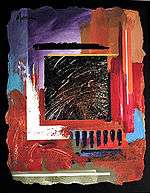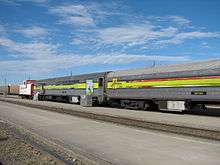Artrain USA

Artrain is a traveling art museum on a train.[1] It consists of three gallery cars, with two more cars in support, and travels widely in a given region of the United States, with the region changing every year. It was intended as a short-lived program but has been active for over 30 years due to popular demand.
History
Artrain USA is believed to be the longest-running special-display train in the United States (the Freedom Trains traveled more widely but were special-purpose exhibitions, first in the late 1940s, and then for the United States Bicentennial celebration in the late 1970s). Though it was intended as a short-lived, statewide program, the Michigan Artrain welcomed 191,000 visitors in 28 cities in the first year, 1971. Soon after, it expanded its focus to nationwide touring.
Artrain began in 1971 as a project of the "Michigan Council for the Arts",[2] and initially toured Michigan, visiting small towns that did not have their own museums. Throughout the summer of 1971 Michigan Artrain toured across the state of Michigan with over 191,000 visitors in 28 Michigan communities visiting the train’s vintage baggage car converted to a studio car where 2 resident artists that travelled with the train demonstrated and explained the many different types of art processes and mediums. Soon after, thanks to popular demand, a separate foundation was set up, and the tour area was broadened to the entire United States with the help of the National Endowment for the Arts (NEA). The first tour beyond Michigan commenced in 1973.[3] Since then, it has hosted 15 or more different exhibitions. Funding of about US$1.5 million annually is through private donations and government grants.[4] In addition, significant in-kind support from the railways it travels over helps reduce funding needs.[5] The name was changed to "Artrain USA" in 1999 to reflect the national mission.
The Artrain USA organization is an independent nonprofit and has headquarters on North Main Street in Ann Arbor, Michigan.
Exhibits
The current exhibit is entitled Native Views: Influences of Modern Culture, and features David Bradley's watercolor, The Santa Fe Super Chief, significant and relevant because the Atchison, Topeka and Santa Fe Railway (ATSF) used a lot of native theming in its train names, including its most famous train, the Super Chief. Images from the current exhibition (which are copyrighted) can be viewed in this gallery on the artrainusa.org site.
Most works exhibited are paintings, although some computer graphics and three-dimensional art are included. The shock and vibration potential of train travel require that sculptures and other three-dimensional works, especially if they are at all fragile, be transported in protective cases between stops, which increases the setup time enough that an all-sculpture exhibition would be prohibitive.
The train, despite limited space, has a small Operation Lifesaver exhibit to promote railroad safety awareness.
Operations, visit logistics

Artrain USA tours different regions of the country in different years, cycling through a given region once every four or so years, typically when the exhibition changes. It is on tour 11 months a year, traveling about 12,000 miles per year. In 2006, it is operating in the Western United States and in 2007, will be operating in the Midwest and Deep South. The one month each year that the train is not touring, it is at its home base in Ann Arbor, where the cars undergo maintenance. Some years the exhibit may be changed out as well.
Planning (to locate a 450 or more foot long siding that is more or less straight, with road/parking access nearby that does not require crossing active tracks, to secure local volunteers and site prep, and to arrange for publicity) is carried out entirely without a site visit to reduce costs. The headquarters staff provides detailed sponsor and volunteer guidelines, as well as publicity and planning materials, to help the community achieve a successful visit.[6]
Rolling Stock
Artrain USA consists of several (currently three) exhibit cars with walk-through galleries (1940s vintage Budd passenger cars, rebuilt to remove windows) a studio/gift shop car in which staff and visiting artists give working demonstrations, and crew quarters, which, as of June 2006, consist of a caboose but are slated to be changed over to a former New York Central Railroad round-end observation car. The number of exhibit cars is constrained by the total train-length restriction (longer trains require longer sidings, reducing the number of sites that could host the train).
Staffing
A touring staff travels with the train. It is divided into a facilities staff concerned with mechanicals, equipment and so forth, and an arts staff. Artrain USA provides fellowships to young artists (most staff members are in their 20s and 30s) willing to travel with the train and demonstrate their talents. The staff also collect tickets—admission is usually free but tickets are used to track attendance. The staff often give tours to interested railroad personnel as a way to help build understanding of the train's mission and increase service responsiveness.[7]
References
- ↑ Artrain USA: About Artrain Archived June 15, 2006, at the Wayback Machine.. Accessed June 18 2006.
- ↑ Now known as the "Michigan Council for Arts and Cultural Affairs" with information located here
- ↑ From the history Archived June 29, 2006, at the Wayback Machine. page of the Artrain site.
- ↑ Trains July 2006, Artrain USA article, page 58
- ↑ All 4 Class I railways move the train for free and provide siding space as needed. Several members of the foundation board are railway officials. The value of this in-kind contribution is considerable. Trains article
- ↑ This report Archived May 8, 2006, at the Wayback Machine. of a successful visit to Skykomish, Washington shows the level of volunteer involvement and typical onsite preparation
- ↑ Trains article, pp 60-61
External links
- Artrain USA site main page
- Southern Living July 2000 article
- Railway Age June 2005 article
- Ann Arbor News article on NEA 2006-2007 grant.